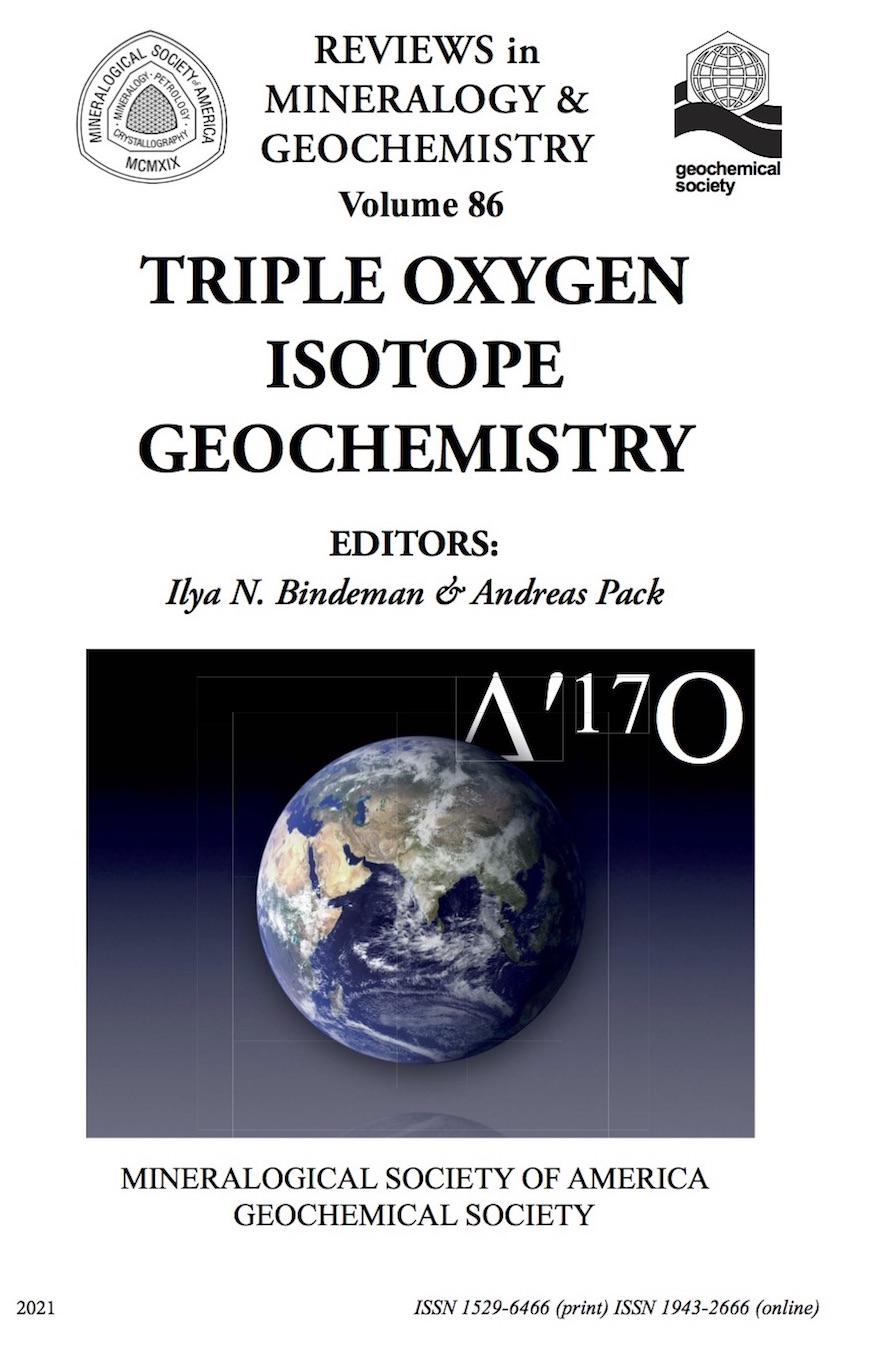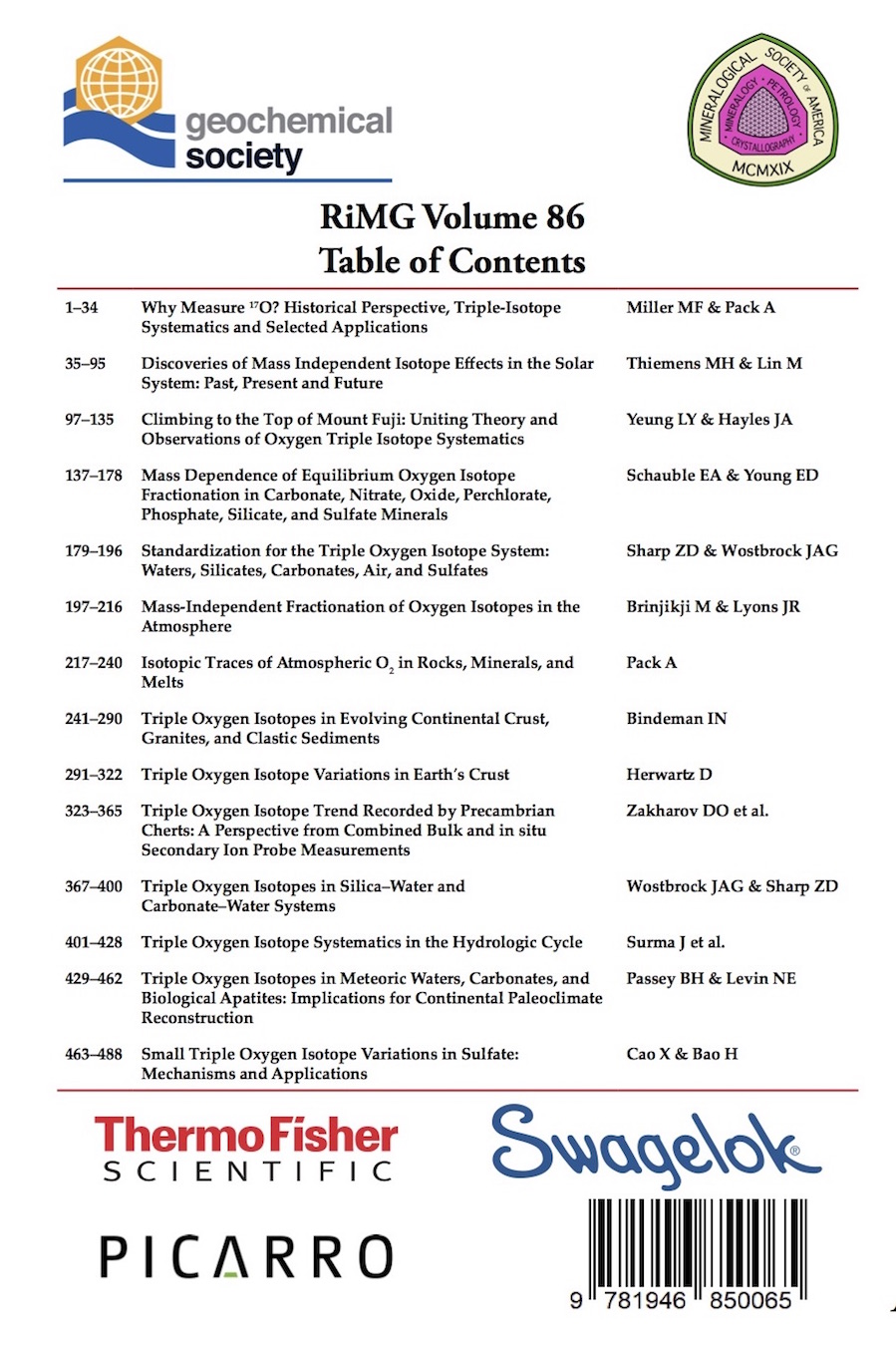

Mineralogical Society of America, Founded December 30, 1919
Subscriber Access MinPubs.org Pay-Per-View
Order Publications Online (25% discount for MSA, CMS and GS members, except shipping)


2021, i-xv1 + 496 pages. ISBN 978-1-946850-06-5
Description
Why this new volume? During the past two decades, two major and exciting fields have emerged in the science of stable isotope geochemistry, both related to understanding tiny variations (down into the lower ppm range) in the minor isotopologue abundances. The first field is related to the distribution of “clumping” of heavy isotopes in molecules, such as CO2 or CH4; the second field is the use of small variations in all three oxygen isotopes. Both approaches allow researchers to resolve absolute temperatures, previously masked process pathways, and exchange between various reservoirs.
In this new volume of Reviews in Mineralogy and Geochemistry we concentrate on understanding the latter—understanding of variations among ratios of all three isotopes of oxygen, with primary emphasis on terrestrial systems. Triple oxygen isotope variations may be related to large, mass-independent fractionation effects such observed in the Earth atmosphere or may be small and related to minute variations due to purely mass-dependent processes. Recent advancements in analytical resolution now allow for the identification of processes and distinct reservoirs that were formerly hidden in the paradigm of a “single terrestrial fractionation line”. New, high-resolution measurements are accompanied by advances in theoretical calculations that dovetail with empirical calibrations and applications throughout this volume.
Here, we bring together the leading researchers and asked them to summarize the new discoveries in their field of expertise. The result is a volume with 14 chapters spanning a wide range of subjects: from ab-initio theoretical approaches to observation of triple oxygen isotope variations in the Earth litho-, hydro- and atmosphere.
Triple Oxygen Isotope Geochemistry is a young and rapidly evolving field and some of the observations reported in this volume will undoubtedly be modified in the future as new discoveries and improved protocols are developed in the coming years. The triple oxygen isotope concepts presented in this volume, however, will hopefully prove valuable to new entrants in this field and lay a foundation for future growth.
Title Page
p. i
Copyright
p. ii
Title
p. iii
Preface
p. iv
Table of Contents
p. vi-xiv
Chapter 1. Why Measure 17O? Historical Perspective, Triple-Isotope Systematics and Selected Applications
by Martin F. Miller and Andreas Pack, p. 1–34
Chapter 2. Discoveries of Mass Independent Isotope Effects in the Solar System: Past, Present and Future
by Mark H. Thiemens and Mang Lin, p. 35–96
Chapter 3. Climbing to the Top of Mount Fuji: Uniting Theory and Observations of Oxygen Triple Isotope Systematics
by Laurence Y. Yeung and Justin A. Hayles, p. 97–136
Chapter 4. Mass Dependence of Equilibrium Oxygen Isotope Fractionation in Carbonate, Nitrate, Oxide, Perchlorate, Phosphate, Silicate, and Sulfate Minerals
by Edwin A. Schauble and Edward D. Young, p. 137–178
Chapter 5. Standardization for the Triple Oxygen Isotope System: Waters, Silicates, Carbonates, Air, and Sulfates
by Zachary D. Sharp and Jordan A.G. Wostbrock, p. 179–196
Chapter 6. Mass-Independent Fractionation of Oxygen Isotopes in the Atmosphere
by Marah Brinjikji and James R. Lyons, p. 197–216
Chapter 7. Isotopic Traces of Atmospheric O2 in Rocks, Minerals, and Melts
by Andreas Pack, p. 217–240
Chapter 8. Triple Oxygen Isotopes in Evolving Continental Crust, Granites, and Clastic Sediments
by Ilya N. Bindeman, p. 241-290
Chapter 9. Triple Oxygen Isotope Variations in Earth’s Crust
by Daniel Herwartz, p. 291–322
Chapter 10. Triple Oxygen Isotope Trend Recorded by Precambrian Cherts: A Perspective from Combined Bulk and in situ Secondary Ion Probe Measurements
by D.O. Zakharov, J. Marin-Carbonne, J. Alleon, and I.N. Bindeman, p. 323–366
Supplemental Materials for Chapter 10
Chapter 11. Triple Oxygen Isotopes in Silica–Water and Carbonate–Water Systems by Jordan A.G. Wostbrock and Zachary D. Sharp, p. 367–400
Chapter 12. Triple Oxygen Isotope Systematics in the Hydrologic Cycle
by Jakub Surma, Sergey Assonov and Michael Staubwasser, p. 401–428
Chapter 13. Triple Oxygen Isotopes in Meteoric Waters, Carbonates, and Biological Apatites: Implications for Continental Paleoclimate Reconstruction
by Benjamin H. Passey and Naomi E. Levin, p. 429–462
Chapter 14. Small Triple Oxygen Isotope Variations in Sulfate: Mechanisms and Applications
by Xiaobin Cao and Huiming Bao, p. 463–488